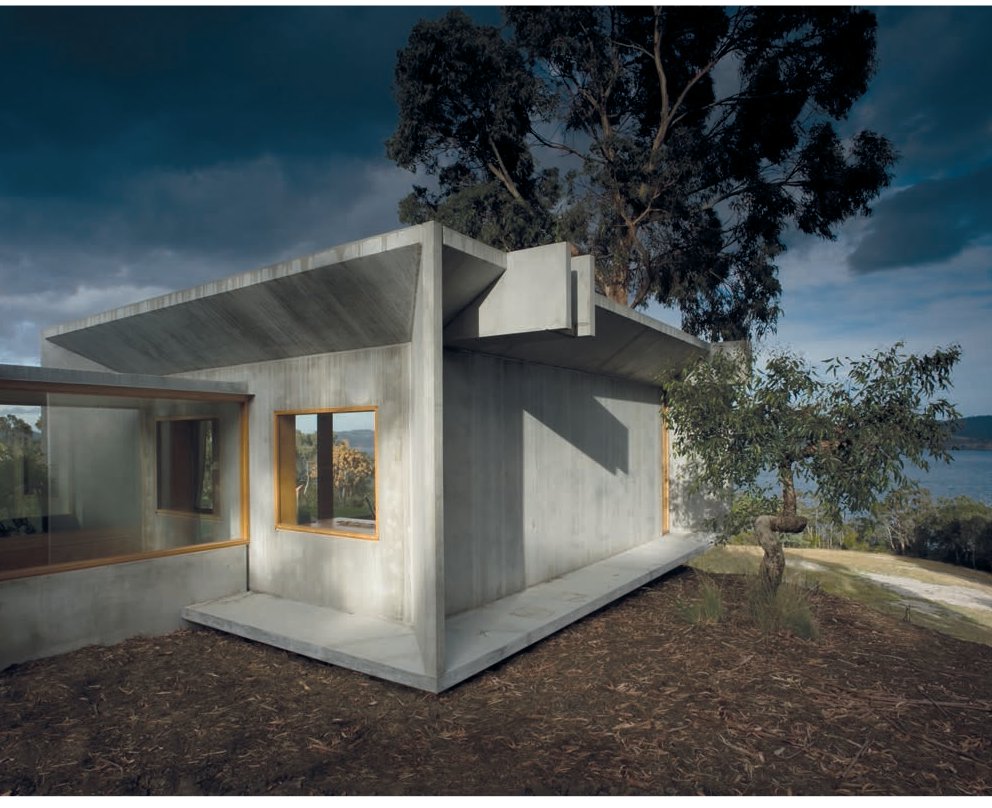Dwellings designed along the principles of passive solar gain do not require mechanical means to gather and utilize the sun’s energy and enhance their ventilation (Sustainable Sources 2011b). According to the California Energy Commission (2011), by designing a house to take full advantage of the sun’s heat, energy consumption can be reduced by 30 to 40 per cent. Despite appearing to be simple, design for passive solar gain requires careful attention to details and application.
The two key aspects that need to be considered in passive design are the dwelling’s exterior and interior. For the former, it is important to site the house properly and account for seasonal changes, solar cycles and local vegetation, while for the latter, the deciding factors may include daylight, window placement and heating requirements for each room.
During the hot summer months, a well-designed structure utilizes several techniques for passively cooling a building through either shading or natural ventilation. Shading methods may include the use of well-placed vegetation, properly designed overhangs and sun blockers, curtains and shutters. Passive cooling also extends to natural ventilation and airflow in techniques such as ‘wing walls’ and ‘thermal chimneys’, which will be illustrated below.
A passive solar dwelling must also be capable of passive heating. Once a house is thoroughly insulated, there are five methods through which it can passively gain heat: from internal sources, direct gain, Trombe walls, thermosiphons and the inherent thermal mass, which will also be discussed below (Sustainable Sources 2011d, Tanha 2010, Sassi 2006).

Figure 12.1: Section through a house that was designed with passive heating and cooling considerations.
A house should be orientated so that it has an elongated side facing south (or north in the southern hemisphere). Although having it face true south, rather than magnetic south, is highly recommended, the orientation can vary by up to 20 degrees off true south with minimal effect on solar input (CEC 2011). This orientation allows the building’s side to gain energy between 9 a.m. and 3 p.m. during the cold season (Sustainable Sources 2011b). In summertime, when the sun is high in the sky, it still moves along a southward arc in the northern hemisphere. Situating the building to take advantage of this arc can cut the total energy usage by 30 to 40 per cent (CEC 2011). In colder climates, however, such an organization can reduce the heat load by up to 60 per cent (Johnston and Gibson 2010).
It is also important to consider topographical conditions and neighbouring structures when designing passive buildings. If possible, a building should not be positioned where a hill or a building will block solar exposure. This is especially important in the winter months when the sun is significantly lower than in the summer (Friedman 2007). To aid in calculating the shadows cast by neighbouring masses, and subsequently their effect on the design, the use of commonly available software is recommended.
Interior arrangement for passive solar dwellings is also key to achieving maximum solar input. Primary living spaces, such as living rooms, kitchens and bedrooms, which require the most heat and light, should be placed along the wall with the highest sun exposure. This wall should also contain large windows. Furthermore, to reduce heat loss from the northern facade, it is recommended that only 5 to 10 per cent of its surface should be fenestrated (Friedman 2007). Secondary or less used spaces, such as utility rooms and stairs, should be located on the north side (Sassi 2006, Sustainable Sources 2011b). Properly designed passive solar dwellings should also have open floor plans that allow warm air to easily circulate (Sustainable Sources 2011b).
One of the best ways to shade a dwelling is to plant trees or use existing trees. Planting deciduous trees blocks the hot summer rays, while allowing the winter sun to shine through. In general, leafy trees allow light transmission of 10 to 25 per cent compared to a 60 to 70 per cent when bare (Sassi 2006). Such methods not only shade, but are also known to reduce the ambient temperature around a dwelling. Natural vegetative processes such, as photosynthesis and evaporation, use up the sun’s energy and prevent it from being absorbed into the building and its surroundings (Sassi 2006).
Using man-made features such as roofing overhangs can also be used to create shade. Due to the fact that the sun’s rays are higher in the summer and lower in the winter, the roof can be extended to block summer rays from entering a window without blocking the winter sun (Friedman 2007). It is also possible to add shutters above windows that are too low to benefit from an overhanging roof. The same effect can be reproduced by even simpler man-made devices, such as curtains or shutters, which can be closed or opened manually when needed. Such details should be introduced to avoid heat absorption and reflect the sun’s rays away from the dwelling instead (Sassi 2006).
•High energy costs
•Interest in vernacular design principles
•Reduced reliance on costly mechanical means
INNOVATIONS
•New software aids in energy calculations
•Better correlation between landscaping and energy efficiency
•New glazing technologies
•Better insulation techniques and products
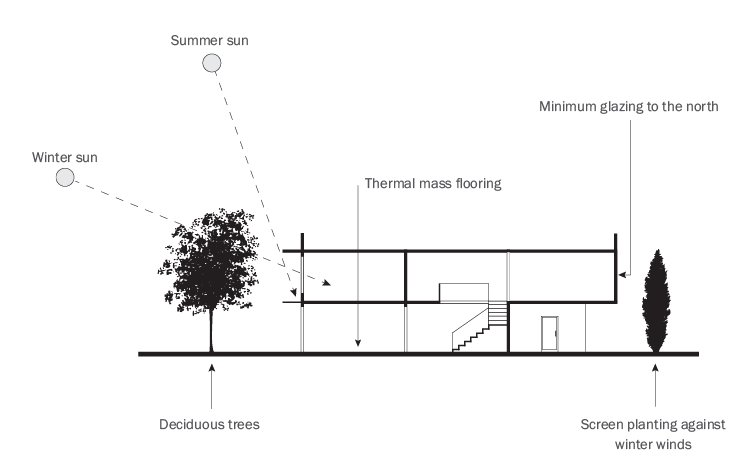
Figure 12.2: A combination of an open-plan design and a thermal chimney can contribute to the enhancement of interior ventilation.
The principle of reflecting away the sun’s energy when required is also inherent in more innovative technologies such as electrochromic and thermochromic glass. Electrochromic glass, or switchable glass, is a clear sheet of glass that – with a small burst of electricity – can change opacity to become solid and reflective. Wall switches, remote controls, movement sensors, light sensors or timers are programmed to initiate the small burst of energy. Furthermore, this glass can be customized or ‘tuned’ to control the precise amount of light, glare and heat passing through, or reflecting off, the window (SmartGlass International 2010). This ability to customize the effect of the glazing makes it a very viable method of passively cooling a building.
Thermochromic glass is made from a thin, transparent film laminated between two panes of glass. When in direct sunlight, the glass passively turns black, or tints, according to how much sun strikes the glass. In its fully tinted state, the glass allows a transmission of only 10 per cent of visible light, as compared to its 60 per cent transmittance rate when it is in a clear state. It can take up to 30 minutes to change from fully tinted to clear after being removed from the sun’s presence (Millet 2010).
Lastly, it is important to insulate the structure adequately so that any heat gained does not escape through convection or conduction. Having thick walls, high-efficiency low-e windows and glass doors, an air-tight membrane and a proper heat exchange system, not only prevents drafts, cold walls and cold floors, but also greatly reduces heating costs. The effectiveness of sealed buildings can be verified through a ‘blow test’, which can demonstrate loss of air when the building is under pressure and not properly constructed (Rosenthal 2008).
Once insulated, there are other methods through which a passive building can retain heat. Walls with a high thermal mass typically take advantage of 60 to 70 per cent of the sun’s radiant energy by storing it (Sustainable Sources 2011d). It is recommended to use thermal-mass materials not exceeding 15 cm (6 in) in thickness, since heat does not penetrate more than 10 to 15 cm (4 to 6 in) into a mass (Sustainable Sources 2011d, Tanha 2010). Furthermore, for every 0.09 m2 (1 sq ft) of glass on the facade, there should be 68 kg (150 lb) of masonry with a surface area nine times that of the windows exposed to direct sunlight (Sustainable Sources 2011).
It is also possible to gain heat through indirect gain. These systems function by placing a thermal mass between the sun and the living areas. When the sunlight heats up the thermal mass, the energy is transferred to the living space by conduction with an efficiency rate of 30 to 45 per cent (Sustainable Sources 2011d). Two such indirect systems can be used: Trombe walls and roof pond systems. Trombe walls consist of a small air gap between a glazing and a dark metal absorber attached to the facade. Cool building air enters into the bottom of the wall, which is then heated by the sun and, due to convection, rises to the top of the wall and re-enters the building via a small opening (Juneau 2011). At night-time, however, it is important to close off the air vents in the wall to slow down the cooling of the thermal mass. The other indirect gain system is a roof pond system. This consists of 15 to 30 cm (6 to 12 in) of water stored in plastic or fibreglass containers covered by glazing. The water is warmed by the sun’s energy and it then slowly heats the structure beneath it. It is important to note, however, that this system may require drainage as well as structural roofing support for up to 333 kg/m2 (65 lb/sq ft) (Sustainable Sources 2011d).
Heat can also be gained passively by a thermosiphon. A thermosiphon is a water-based solar heater that relies upon ‘natural convection to move water from the collectors to the storage tank, which is located above the collector’ (Johnston and Gibson 2010). The collector for the system can be either a flat-plate or an evacuated tube collector (Tanha 2010, Sustainable Sources 2011a, Sassi 2006).
In recent years, we have seen significant development of technological means aimed at improving the dwelling’s energy efficiency. Bear in mind, though, that simple, age-old methods are also of great value and they need to be considered prior to investing in mechanical and often very costly systems.
12.1 DESIGN FOR PASSIVE SOLAR GAIN |
|
Project |
Trial Bay House |
Location |
Tasmania, Australia |
Architect |
James Jones/HRV Architects |
The Trial Bay House was designed to allow its occupants to look out over the serene views of the D’Entrecasteaux Channel and was positioned to take advantage of the maritime climate of Tasmania: as an island between the Indian and Pacific Oceans, the yearround temperature is moderated by the large expanses of water. The house has stunning views of the plateaus, mountains and forests and architect James Jones was inspired by the aperture of a photographic lens to try to frame and capture the landscape.
As a renovation of an existing structure, the one-storey house measuring 475 m2 (5,110 sq ft), is an architectural intervention that contrasts the old timber-pitched roofs with new, precast concrete walls. The addition of a new living room, verandah, courtyard and garage initiated a complete reorganization of the dwelling, which was originally built in the 1970s, and it exemplifies considerations of sustainability and health.
In the cooler seasons, when the average temperature hovers around 10°C (46°F ), the concrete walls and floors that are exposed to the sun during the day release the stored heat at night. In the warm seasons, the precast concrete roof panels block direct sunlight from entering the interior. The double-glazed timber windows, which are orientated in different directions, are operable for cross-ventilation throughout the house.

Allowing a panoramic view was a key design objective.
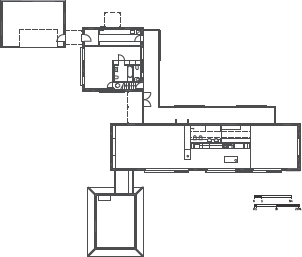
The design saw an addition to a 1970s timber-frame house.
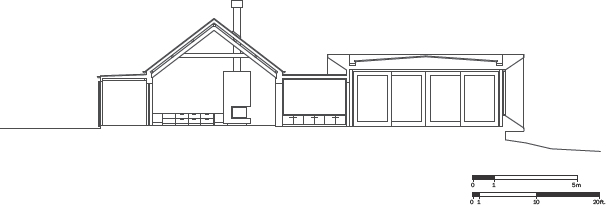
Section showing the concrete structure on the right.
The fact that the occupant has been a film director and a screenwriter inspired the overall design. The architect aimed to create a unique framing of the view, where the viewfinder is focused on the distant water canals and islands. For example, the occupants can experience the scenery inside the Channel Room, which is separated by a passageway from the core of the house. Floor-to-ceiling windows are strategically orientated to the north for optimal light and view.
Ecological features include rainwater harvesting and heat collection. The house is designed to collect a large amount of rainfall each season and stores it in cisterns, with solar collectors for water heating. While extreme temperatures rarely occur in Tasmania, the integration of passive design for cooling and heating creates a comfortable and pleasant living space for the occupants with minimal use of energy. The Trial Bay House was recognized by the Australian Institute of Architects with the Robin Boyd Award in the residential category in 2010.
Double-glazed patio door and windows permit cross-ventilation and contributes to energy-efficiency.
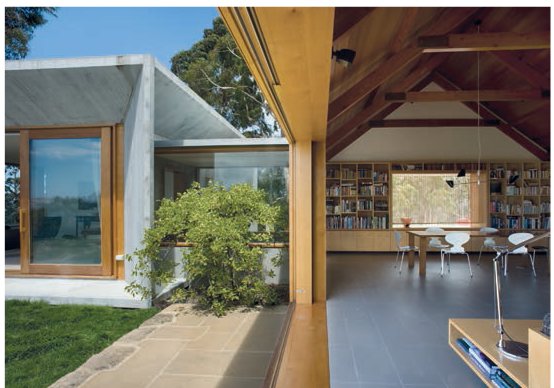
The concrete structure on the left is instrumental as a thermal mass.

A close-up of the timber frame structure’s interior.
The Channel View room is constructed of concrete.


